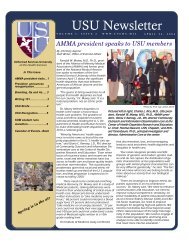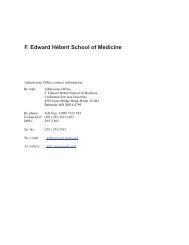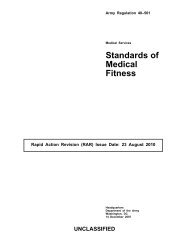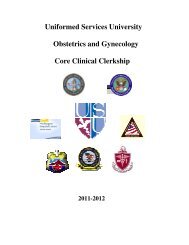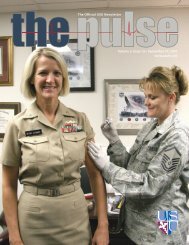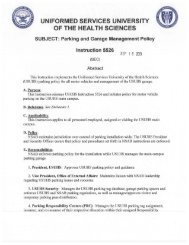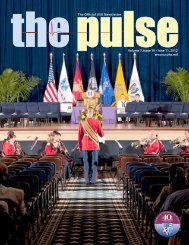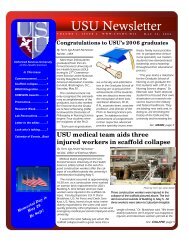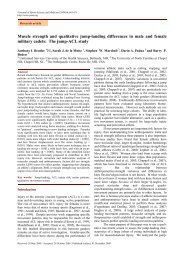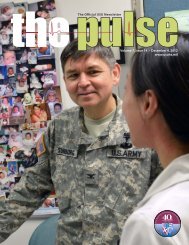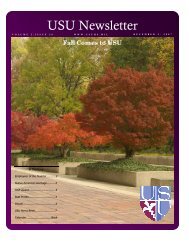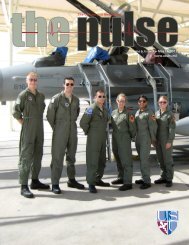Annual Report - Uniformed Services University of the Health Sciences
Annual Report - Uniformed Services University of the Health Sciences
Annual Report - Uniformed Services University of the Health Sciences
Create successful ePaper yourself
Turn your PDF publications into a flip-book with our unique Google optimized e-Paper software.
ResearchIn addition to providing world-class educational opportunities, USU is dedicated to visionary military and publichealth-relevant research and has a reputation as a worldwide center <strong>of</strong> excellence in areas such as disastermedicine, infectious diseases, preventive medicine, tropical medicine and adaptation to extreme environments.<strong>University</strong> researchers conduct investigations to ensure military health and readiness, and for <strong>the</strong> broad benefit<strong>of</strong> humankind. Collaboration is key, with USU scientists conducting clinical and laboratory investigations sideby-sidewith leading researchers at federal and private institutions in <strong>the</strong> U.S. and around <strong>the</strong> world.IMPROVING BLAST INJURY OUTCOMESCurrently, improvised explosive devices are <strong>the</strong> mostcommon cause <strong>of</strong> combat injuries. Blasts frequentlyresult in traumatic brain injury, as well as chronicdisabilities that can affect everyday functions. The mostfrequently occurring symptom <strong>of</strong> blast traumatic braininjury (BTBI) is memoryimpairment.An interdisciplinaryteam <strong>of</strong> USU researchersled by Christine E.Kasper, Ph.D., R.N., aPr<strong>of</strong>essor in <strong>the</strong> GraduateSchool <strong>of</strong> Nursing andfaculty with <strong>the</strong> Office <strong>of</strong>Nursing <strong>Services</strong> at <strong>the</strong>Department <strong>of</strong> VeteransAffairs Central Office,received a three-yeargrant from <strong>the</strong> VA tocharacterize <strong>the</strong> cellular, molecular and behavioralconsequences <strong>of</strong> moderate and severe BTBI. Theresearchers also will test <strong>the</strong>ir <strong>the</strong>ory that treatment withan anti-inflammatory medication, along with behavioralstimulation, will produce neuro-regeneration leadingto better patient outcomes. This is a departure from <strong>the</strong>traditional approach <strong>of</strong> severely limiting <strong>the</strong> amount <strong>of</strong>stimuli to which a patient with TBI is exposed.The cross-disciplinary research team includes DenesAgoston, M.D., Ph.D., an Associate Pr<strong>of</strong>essor in <strong>the</strong>Department <strong>of</strong> Anatomy, Physiology and Genetics, andNeil Grunberg, Ph.D., a Pr<strong>of</strong>essor in <strong>the</strong> Department <strong>of</strong>Medical and Clinical Psychology. Colonel Ge<strong>of</strong>freyLing, M.D., Ph.D., Director <strong>of</strong> <strong>the</strong> Division <strong>of</strong> CriticalCare Medicine, Vice Chair <strong>of</strong> <strong>the</strong> Department <strong>of</strong>Neurology and a Pr<strong>of</strong>essor in <strong>the</strong> Departments <strong>of</strong>Anes<strong>the</strong>siology, Neurology and Surgery and JosephLong, Ph.D., at <strong>the</strong> Walter Reed Army Institute <strong>of</strong>Research, are also collaborators.Collaborating for SuccessIts close proximity to prestigious research institutions, including <strong>the</strong>National Institutes <strong>of</strong> <strong>Health</strong>, affords USU faculty and studentssingular opportunities to interact. They have a deep sense <strong>of</strong>shared mission among <strong>the</strong>mselves and o<strong>the</strong>rs within <strong>the</strong> militaryhealth system, lending itself to an extraordinary team spirit rarelyfound at o<strong>the</strong>r educational institutions.“The wealth <strong>of</strong> research opportunities here is mindblowing…You have to cross cut if you want your research tohave clinical relevance. Everyone here is so welcoming aboutcollaborations and talking about research. It’s a joy.”Students at USU benefit from this atmosphere and location,as well. “One <strong>of</strong> my doctoral students is back and forth atNIH all <strong>the</strong> time… Some <strong>of</strong> my students are also workingon a study we’re doing with <strong>the</strong> Armed Forces RadiobiologyResearch Institute...”Christine E. Kasper, Ph.D., R.N.24




